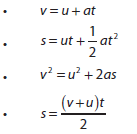|
Nature of science:
Observations: The ideas of motion are fundamental to many areas of physics, providing a link to the consideration of forces and their implication. The kinematic equations for uniform acceleration were developed through careful observations of the natural world. (1.8)
|
Understandings:
- Distance and displacement
- Speed and velocity
- Acceleration
- Graphs describing motion
- Equations of motion for uniform acceleration
- Projectile motion
- Fluid resistance and terminal speed
Applications and skills:
- Determining instantaneous and average values for velocity, speed and acceleration
- Solving problems using equations of motion for uniform acceleration
- Sketching and interpreting motion graphs
- Determining the acceleration of free-fall experimentally
- Analysing projectile motion, including the resolution of vertical and horizontal components of acceleration, velocity and displacement
- Qualitatively describing the effect of fluid resistance on falling objects or projectiles, including reaching terminal speed
|
International-mindedness:
- International cooperation is needed for tracking shipping, land-based transport, aircraft and objects in space
Theory of knowledge:
- The independence of horizontal and vertical motion in projectile motion seems to be counter-intuitive. How do scientists work around their intuitions? How do scientists make use of their intuitions?
Utilization:
- Diving, parachuting and similar activities where fluid resistance affects motion
- The accurate use of ballistics requires careful analysis
- Biomechanics (see Sports, exercise and health science SL sub-topic 4.3)
- Quadratic functions (see Mathematics HL sub-topic 2.6; Mathematics SL
sub-topic 2.4; Mathematical studies SL sub-topic 6.3)
- The kinematic equations are treated in calculus form in Mathematics HL sub-topic 6.6 and Mathematics SL sub-topic 6.6
|
Guidance:
- Calculations will be restricted to those neglecting air resistance
- Projectile motion will only involve problems using a constant value of g close to the surface of the Earth
- The equation of the path of a projectile will not be required
Data booklet reference:

|
Aims:
- Aim 2: much of the development of classical physics has been built on the advances in kinematics
- Aim 6: experiments, including use of data logging, could include (but are not limited to): determination of g, estimating speed using travel timetables, analysing projectile motion, and investigating motion through a fluid
- Aim 7: technology has allowed for more accurate and precise measurements of motion, including video analysis of real-life projectiles and modelling/ simulations of terminal velocity
|


